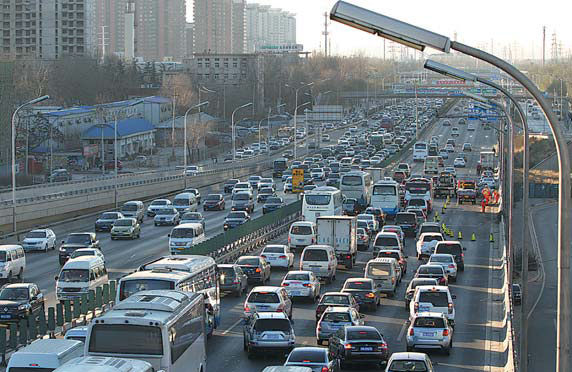Sustainable transport equals livable cities
Updated: 2016-01-30 08:19
By Liu Daizong(China Daily)
|
||||||||
 |
|
The Fourth Ring Road in Beijing in a morning rush hour. City authorities are working on solutions to ease the pressures on traffic in the city. [Zhuo Ensen / For China Daily] |
To build a livable city that focuses on sustainable development, the authorities in Beijing have to come up with a package of solutions to the transportation problems, including severe traffic congestion. Among the solutions should be subtasks, including the shift from traffic governance that is aimed at meeting the existing demand for transportation, such as building roads and bridges, to managing the flow of transport by reducing people's dependence on cars through the regulation of parking norms and redistribution of road resources by making it easier for people to use bicycles and public transport vehicles to commute.
Automobiles on average contribute 30-40 percent of PM2.5 (particulate matter smaller than 2.5 microns in diameter that can be inhaled by and harm humans) in cities across the world. The figure in Beijing is about 31 percent.
Therefore, the need is to strike the right balance between traffic and economic development, because traffic jams increase travel costs and have a huge impact on the overall economy of a city.
Since urban mobility depends both on economic development and efficient transport networks, we have to change the way we commute to reduce traffic on the roads. For instance, while continuing to expand public transport networks we also have to increase the cost of driving cars.
Take London for example. By imposing congestion charge on vehicles entering the center of the city, it has not only made driving in downtown areas an expensive affair but also found a convenient way of raising part of the funds to further modernize the public transport system. This is a good way of facilitating urban mobility as well as of improving the living conditions of residents.
- Beijing to support flextime in CBD and Zhongguancun areas to ease traffic
- Ride-sharing apps accused of slowing down traffic in Beijing
- Beijing mulls traffic ban for winter heating season
- One-way traffic prompts tourism revamp
- Beijing takes action to ease its thick traffic congestion
- Proper use of congestion fee can cut traffic jams
- Global health entering new era: WHO chief
- Brazil's planning minister steps aside after recordings revelation
- Vietnam, US adopt joint statement on advancing comprehensive partnership
- European border closures 'inhumane': UN refugee agency
- Japan's foreign minister calls A-bombings extremely regrettable
- Fukushima impact unprecedented for oceans: US expert

 Stars of Lijiang River: Elderly brothers with white beards
Stars of Lijiang River: Elderly brothers with white beards
 Wealthy Chinese children paying money to learn British manners
Wealthy Chinese children paying money to learn British manners
 Military-style wedding: Fighter jets, grooms in dashing uniforms
Military-style wedding: Fighter jets, grooms in dashing uniforms
 Striking photos around the world: May 16 - May 22
Striking photos around the world: May 16 - May 22
 Robots help elderly in nursing home in east China
Robots help elderly in nursing home in east China
 Hanging in the air: Chongqing holds rescue drill
Hanging in the air: Chongqing holds rescue drill
 2.1-ton tofu finishes in two hours in central China
2.1-ton tofu finishes in two hours in central China
 Six things you may not know about Grain Buds
Six things you may not know about Grain Buds
Most Viewed
Editor's Picks

|

|

|

|

|

|
Today's Top News
Liang avoids jail in shooting death
China's finance minister addresses ratings downgrade
Duke alumni visit Chinese Embassy
Marriott unlikely to top Anbang offer for Starwood: Observers
Chinese biopharma debuts on Nasdaq
What ends Jeb Bush's White House hopes
Investigation for Nicolas's campaign
Will US-ASEAN meeting be good for region?
US Weekly

|

|







